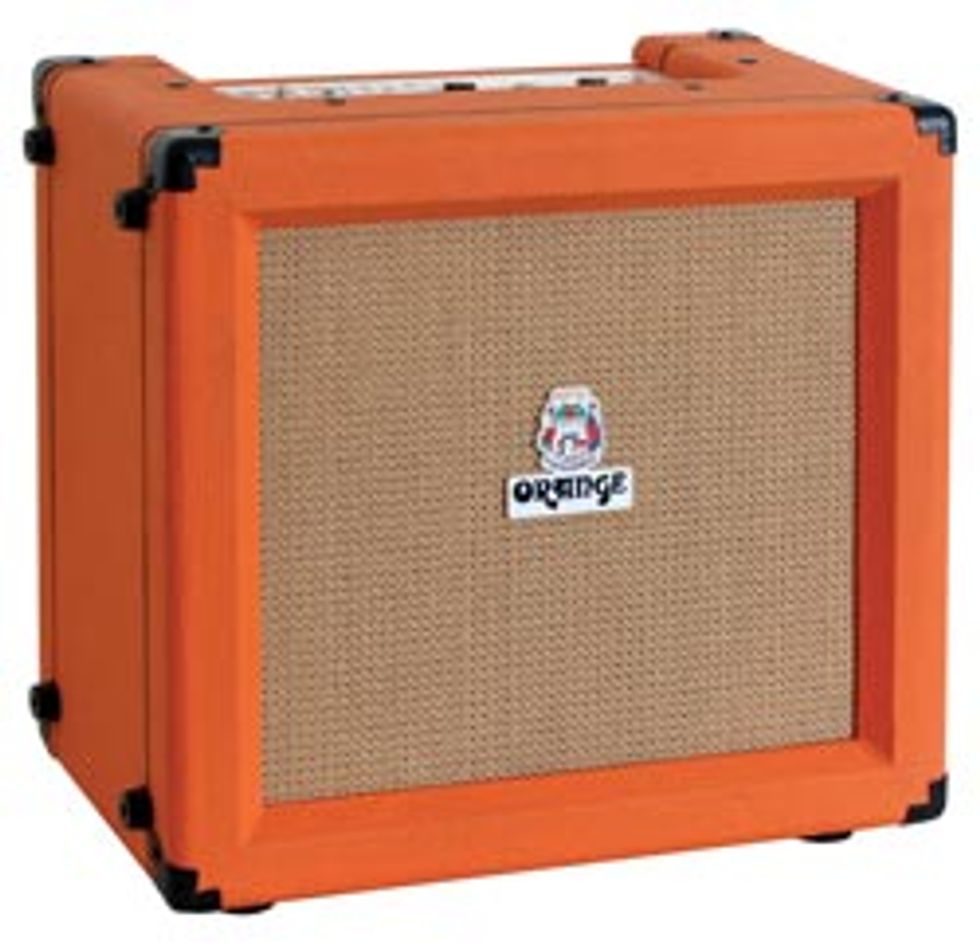 | |
| Download Example 1 | |
| Download Example 2 | |
In more recent times, this situation has been addressed with modeling consoles and amps that aim to simulate that tone while providing the benefits of a controlled studio space. On the other hand, not all guitarists are convinced it’s the best solution. Thus, the Tiny Terror, designed and produced by the illustrious Orange Amplification, entered the battle a few years ago to tackle this issue head on. Its cute, lunchbox-sized exterior deceived many, who laughed at first glance, but its incredible tone and flexibility quickly drowned the giggles and scoffs. The miniature tube head soon became a very highly sought after item, leading the architects at Orange to put their heads together once again to come up with something that could improve upon the original idea. The result is one of their newest creations, the Tiny Terror Combo.
Basically, the Tiny Terror Combo is exactly what it looks like: a Tiny Terror head packed into a 1x12 cabinet. Orange decided not to fix what wasn’t broken, and kept the layout as simple and clean as possible. The head still bundles all the features of the standalone model, including three separate speaker outputs, switchable output between 15 and 7 watts, and a straightforward set of Gain, Tone and Volume knobs. It’s encased in a solid, 18mm plywood cabinet, which also houses a Celestion G12H-30 speaker—certainly capable of handling the amp’s power without an external cabinet. The tube compliment, like the Tiny Terror head, consists of two EL84s in the power section and two ECC83s in the preamp.
The handle is located on the side of the combo, and there are rubber feet on the opposite side as well as on the bottom, so the amp can be placed either upright or on its side. After examining the top of the combo, it seems designed this way because there wasn’t enough wood there to create a comfortable balance when carrying it, so it was placed on the side instead. But it also adds to the seventies vibe of the amp, as a lot of cabinets back then had single side handles as well.
The Tiny Terror Combo has headroom, but not in spades. The design is very sensitive to the guitar’s output—which is also one of the amp’s best features. A Telecaster will certainly cut more than a Les Paul, but with the Tiny Terror the differences are even more noticeable. With a 1978 set-neck Ibanez Iceman running through it, the inherent upper midrange of the guitar pushed right through, providing a very pleasing growl. The gain doesn’t need to be set very high to get a nice, raunchy tone, either. The Tiny Terror has plenty of it, to the point where some players might want to change out the ECC83 in the first stage with a lower-gain tube, such as an ECC81/12AT7.
Celestion’s G12H-30 70th Anniversary speaker surely handles the output well, but at times sounds a little thin and nasally. This might be due to the stiffness of the new speaker, because when a well-worn Marshall 1x12 with the same speaker was plugged into one of the speaker outs, the thinness subsided somewhat. Either way, the tone itself was fantastic: that fat, killer midrange that Orange is known for is present, combined with that loose, liquidy feel of a small-wattage tube amp. With the preamp gain at 10 o’clock, tone at 11 o’clock, and master volume at a hair past 2 o’clock, the Tiny Terror Combo produced a great, completely usable classic rock tone that was a blast to play. On top of it all, the amp exhibits another famous Orange trait: it cleans up very well when rolling down the volume knob.
The Tiny Terror Combo is a great… no scratch that, an excellent resource for the recording musician. Playing small shows with it is also certainly feasible (and encouraged), and larger gigs if it’s mic’d up. It’s a great representation of what made the original low-wattage tube amps classics; their inherent simplicity in design allowed for great tone and feel. Some players might want to try a tube change, as the Tiny Terror has a massive amount of gain on tap. Some might want to try a different speaker setup. Orange made the potential weakness of putting the Tiny Terror in a combo a strength by leaving the multiple speaker outs. Combined with impressive tone at low and moderate volumes, and great input sensitivity makes it highly recommended as a tool for recording studios everywhere. In the case of the Tiny Terror Combo, less is certainly more.
Buy if...
You want a simple, vintage-looking alternative to mic'ing a raging loud amp to get great tone.
Skip if...
You need multiple channels, an effects loop, 3-band EQ and other amenities.
Rating...
MSRP $819 - Orange Amplification - orangeamps.com |














![Rig Rundown: AFI [2025]](https://www.premierguitar.com/media-library/youtube.jpg?id=62064741&width=1245&height=700&quality=70&coordinates=0%2C0%2C0%2C0)












 Shop Scott's Rig
Shop Scott's Rig